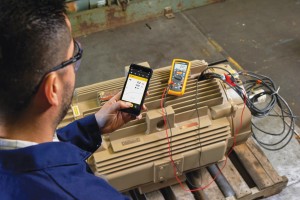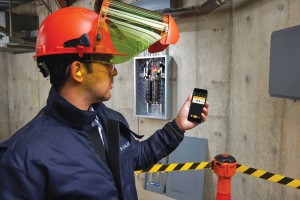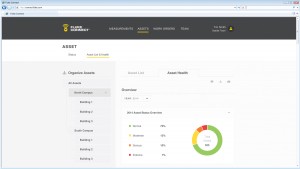
The industrial Internet of things – What is it?
By Fluke Electronics Canada
Test & Measurement IoTIIoT is an enabler that allows maintenance issues to be identified before they become major problems.
You’ve no doubt heard that phrase ‘Internet of Things’ tossed around in media reports or conferences but were unsure what it means. Here’s a simple example. Think about a home security camera that you can view on your smartphone. The picture is sent you via the Internet. That small security camera is the Thing. You have just scratched the surface of the Internet of Things (IoT).
Now think about other devices that have the ability to send information to your phone or straight to the Internet. Fitness bracelets. DVRs. Television sets. Home thermostats. Coffee makers. The list of devices that can connect to and send data across the Internet is growing faster than this article can be typed.
And there’s yet another branch growing off the Internet, the Industrial Internet of Things (IIoT). This is a world where machines send data about their status across the Internet to plant engineers, facilities managers, electrical technicians and others charged with keeping the facility running at full efficiency.
The growth of IIoT can benefit workers today. The technology is here, and it does not mean replacing equipment in the plant. The benefits of IIoT can be had today by deploying measurement devices that send results across the Internet to a database that tracks the status of the assets in a facility.
How it works
Think of the equipment in a manufacturing plant and the parameters that must be measured to keep that equipment running, and think deeper than the process parameters that are continually monitored (the temperature of an oven or the time an object sits in that oven). Think of the electrical consumption of the oven’s heating elements, the vibration of the bearings in fan motor moving the hot air and the heat emitted by the power distribution panel feeding the oven and the fan.
These are parameters that are typically measured on a periodic basis. But the measurements are transient; they only last as long as the user keeps the digits on the display. Worst case, the measurement is made, found to be within acceptable limits, and promptly forgotten. Only slightly better, the measurement is written down manually, which introduces legibility and transcription issues. This data could, and should, be entered into a database, but that also introduces another opportunity for transcription errors.
But the IIoT can change all this. Test tools that take measurements, record the results and transmit those results to smartphones, the cloud and the company’s maintenance database are available today. The essential parameters needed to build a preventive maintenance program – voltage, current, resistance, temperature, insulation breakdown, vibration, even thermal images – can be measured and stored with tools already familiar to maintenance technicians.

Wireless test tools can send test results to a smartphone, to the Internet and to a centralized database … all part of the Industrial Internet of Things (IIoT).
What are the benefits?
Using a set of wireless tools, a smartphone app and an asset management database, technicians can realize several immediate benefits:
* Safety – an IIoT program built around wireless test tools allows the technician to put the measurement tool in locations that could be potentially dangerous to the user. For instance, the technician can disconnect power to a motor following standard safety procedures, then connect current meters to the power lines. The motor can then be reenergized, with only the test tools exposed to electrical hazards or moving machinery. Test results can be read, recorded and stored on the cloud while the technician is a safe distance away.
One benefit of wireless data transmission is keeping workers away from potentially hazardous electrical panels or moving machinery.
* Accuracy – manual recording and transcription of data is replaced by wireless transmission and storage. This makes the technician’s job both faster and more accurate, as transcription errors are eliminated.
* Preventive maintenance – with data stored on the cloud, results for a particular piece of machinery can be reviewed for changes. Potentially damaging trends can be identified before failure occurs, allowing maintenance to be scheduled at a favorable time.
* Speed and efficiency – the technician is no longer required to stay with a piece of test equipment waiting for intermittent faults to occur. Instead, wireless tools will record relevant events while the technician is performing other tasks or not on shift. Even better, measurement data from several tools can be viewed together, helping spot related events. Such interactions would be very difficult to identify using traditional tools.

One benefit of wireless data transmission is keeping workers away from potentially hazardous electrical panels or moving machinery.
What it takes
The IIoT is evolving, offering more capability with each new generation of Internet-enabled equipment. But certain trends are appearing which speed up the acceptance of the tools and technology involved.
One key to IIoT growth is the widespread adoption of the smartphone. Putting a smartphone, essentially a pocket-sized computer with Wi-Fi and Internet connectivity, in the hands of every worker makes the sharing of real-time work-related data possible. More and more organizations expect their staff to carry a smartphones. This makes transmission of measurement data quite feasible. The next step is the office-to-field exchange of historical data, analysis and determination of action, which will mean work orders being sent to the field in real-time. The adoption of tablet PCs that can survive in industrial settings is also making this scenario a reality.
Another trend desired by facility managers is a common software platform supporting all tools and assets in a given plant. This is beginning to take place, with suppliers offering a single software package for collecting, transmitting, storing, organizing and analyzing the data is a big advantage to users.
And an area that should not be overlooked is expertise in the various measurement disciplines. IIoT connectivity doesn’t mean much if the measurement tools do not provide reliable, accurate measurements in a wide range of industrial settings. Facility managers are looking for measurement tools that perform in harsh, industrial environments while turning isolated data points into actionable information. Fortunately, this is also available today.
What it looks like
Workers who are mobile are able to have more tools at their fingertips now than they used to, according to Glenn Gardner, Business Development Manager, Fluke Corporation.
“It’s not just wireless communication between handheld test and measurement equipment like Fluke devices, but it’s also the fact that work order systems that govern the work that they do can be with them in the field on a mobile device,” Gardner said. “Before smartphones became pervasive, it was difficult to access the work order management software system in the field. In addition, most of the test and measurement equipment didn’t have wireless capabilities, so you couldn’t get rich data from the equipment into the work order system without going all the way back to your home office, connecting with a USB cable, and getting it into the computer. It was pretty cumbersome. So the combination of pervasive smartphones/tablets and wirelessly enabled test and measurement tools is what will really drive change in the industry.”
A typical scenario would unfold as follows. Data from weekly maintenance rounds is captured using test tools equipment with wireless connectivity. The data is transmitted through a smartphone and its Internet connection to the analysis dashboard in the maintenance manager’s office. The lead technician notices that current draw from one motor has increased dramatically since the last periodic inspection, and the thermal image associated with that motor shows a significant temperature rise.

IIoT data can be collected and presented in graphical form, prioritizing actions that need to be taken in the field.
IIoT data can be collected and presented in graphical form, prioritizing actions that need to be taken in the field.
The lead technician sends a message to the nearest field technician. Part of that message is the graph showing current measurements and the most recent thermal image of the motor. The field technician performs additional measurements, discovers a phase unbalance, and shares all data with the lead technician. After looking at the details from the field, the lead technician sends a work order to the field, asking for the motor to be replaced. The field tech then can then perform the motor exchange, take and share new measurements, and close the work order.
The takeaway
Measurements have always been a cornerstone of maintenance. Now, because of the IIoT and manufacturers producing new tools that share measurement data across the Internet, that data is becoming more valuable, more actionable and more immediate. IIoT is an enabler that allows maintenance issues to be identified before they become major problems. It also allows field technicians to work safer, faster and more efficiently.
